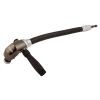Solinst Model 101 Power Winder
Features
- Effortlessly winds longer lengths of tape, cable or tubing on a Solinst reel
- Operates using a standard power drill or driver
- Easy-to-adjust telescoping arms to suit small, medium, and large Solinst reels
- Free ground shipping
- Expedited repair and warranty service
- Lifetime technical support
- More
Overview
The Solinst Model 101 Power Winder is lightweight, easy to attach to the frame of any size Solinst reel-mounted device, and designed to allow ease of use when deploying longer lengths of tape. The convenient Power Winder features adjustable arms and rollers to suit different size reels, as well as other types of Water Level Meters in the market.
Mechanics
A standard drill or driver is used to provide power to the Power Winder, which turns the rollers that are in contact with the reel. The drill can be operated at various speeds, in forward and reverse, to turn the reel and unwind and rewind the tape.
Applications
The Power Winder is ideal for use with Solinst Water Level Measurement Devices, but can also be used with Solinst Tag Lines or pump tubing reels, such as the Model 425 Discrete Interval Samplers. Reels using the Power Winder can be placed on the ground, on a Solinst Field Table, or other flat surface. Small reels can also be secured to a well casing using a tape guide or the optional cinch straps.
In The News
From Florida to the World: How a Smithsonian Research Station is Bridging Gaps in Marine Biology
In the early 2000s, along the coast of northern California, where the redwoods dominate the forests, and the Pacific Ocean shapes shorelines, a Humboldt Univerisity undergraduate student took the first steps into a lifelong love of marine biology. Dean Janiak accepted an invitation to help a graduate student with fieldwork in rocky coastal tide pools, and so began a journey that led him from California to Connecticut to Florida and eventually to the world, where he has facilitated research in communities across the globe. While finishing up his masters of Oceanography from the University of Connecticut, Janiak continued researching fouling communities–marine life that live on hard, often artificial surfaces such as docks–at the Smithsonian Environmental Research Center.
Read MoreWatershed Stewardship in Minnesota: Protecting Valley Creek in the Land of 10,000 Lakes
The Saint Croix Watershed is home to dozens of lakes, rivers, and streams that host an abundance of aquatic life from its tributaries. Valley Creek, a tributary of the St. Croix River, is a designated trout stream and while it is a pristine waterway, ongoing monitoring and stewardship establish a baseline of conditions and protect the creek. Don Wendel and Dllona Clendenen, Minnesota Master Naturalists, Liberal Arts majors, and retired college teachers, are two members of the wetlands research team based out of the Science Museum of Minnesota’s St. Croix Watershed Research Station that monitors Valley Creek throughout the year.
Read MoreFrom Pans to Buoys: Advancing Reservoir Evaporation Rate Monitoring in Texas
In warmer climates like Texas, high reservoir evaporation rates can lead to declines in water level and water availability during droughts, making monitoring essential in order to ensure water security during times of scarcity. According to the Texas Water Development Board (TWDB), evaporation rates in Texas were previously based on data collected from a sparse network of Class A evaporation stations, dating back to the 1960s. These pans were stationed near reservoirs and still remain a widely accepted standardized approach to measuring evaporation rates on land. Monthly pan-to-lake coefficients were developed in the 1980s to connect the data collected from the pans to known lake conditions, extrapolating evaporation rates of the lakes using the pan data.
Read More









